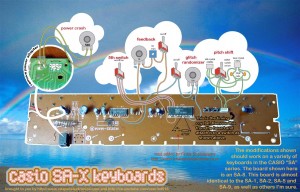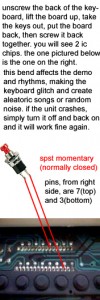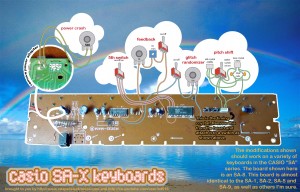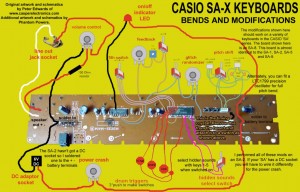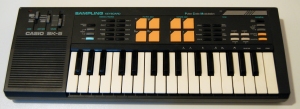
Tag Archive for casio
game consolles and circuit bending
Circuit bending the CASIO SA serie (part2)
by synthvibrations • • 1 Comment
This is a glitch/random bend by Finlay Shakespeare http://www.futuresoundsystems.co.nr .
The mod was originally done on the casio sa1 but it should work with all the sa-serie.
Here is another random/glitch mod I found in a couple of forums:
game consolles and circuit bending, synth tutorials
Circuit Bending the Casio SA-serie
by synthvibrations • • 3 Comments
Doing some circuit bending on my casio keyboards I collected some useful schematics to “safe-bend” the casio sa serie (sa 1 2 5 8 10 20 etc).
The main mod is the one from Casperelectronics that adds interesting bends as the “glitch/randomizer” , “feedback” , “5th add”, “pitch shift” and the classic “power crash”.
In the forum www.circuitbenders.co.uk I found another scheme based on the casper mod but with some adds.
videos
Casio tone MT 45 and Ableton live
by synthvibrations • • 2 Comments
A song made with Ableton Live and the Casiotone MT45 with realtime recording and looping.
Really fun!

synth tutorials
chiptune for dummies (part1)
by synthvibrations • • 2 Comments

8 bit/chiptune music is really fascinating but making it is not always simple or easy.
There are many ways and many kind of “chipgear” , I’ll start making a list of the more common instruments used and then I ‘ll start to describe the process from the easier…
- Nintendo Gameboy + LSDJ & Nanoloop
- Casio/toy keyboards
- Commodore 64 + various softwares on disk and cart
- Commodore 64 as a standalone synth with Cynthcart
- Gameboy emulators on PC + LSDJ
- Nintendo DS + softwares
- Famitracker (NES emulator for PC , midi controllable)
The FAMITRACKER is obviously the easiest way to get into chiptune music making.
It’s a Nintendo NES/FAMICOM emulator that runs on pc with a tracker style sequencer midi controllable.
The NES has 5 track:
- 2 x SQUARE
- TRIANGLE
- NOISE
- SAMPLE
every parameter is controllable from the sequencer step by step, the sample track can play one sample at step, but you can import wav and create a drumkit and use the sample track to play the rhythm with your own samples (bit & frequency reduced with the right aliasing!)
The funny thing is that you can play your melodiy with a moidi keyboard , so it’s easier to compose with it compared to gameboys applications.
Famitracker is free and you can download it here.
The second alternative, always using sw on your computer, is a Gameboy emulator.
Just download a GB emulator and then buy the tracker sw LSDJ (little sound dj) here .
LSDJ is a software that can be used on emulators or with the real thing!
Using it with an emulator is convenient for track saving, loading and recording with a “dry” sound.

LSDJ , like famitracker, is a tracker based on the sound engine of the nintendo, in this case of gameboys, and it has four sources with four tracks:
- SQUARE x 2
- NOISE
- WAVE (sample/wave)
This simple sound generator can create amazing sounds with the implementation of LSDJ, like wavetabling, wavesequencing together with classic squarewave sounds and 4bit samples…
These are the two first sw platforms to check if you want to create micromusic/chiptune in an easy way but with the 8bit style.
It’s all for now..to be continued!
videos
Yamaha VSS30 preset sounds editing
by synthvibrations • • 0 Comments
I’ve made this video to demostrate how the the yamaha VSS30 can mangle the internal waves.
Everything is done only with the VSS , no external efx and NO samples.

game consolles and circuit bending, retrò & vintage
Casio SK-5 review
by synthvibrations • • 2 Comments
The Casio SK serie started with the SK-1 (one of the best selling toy keyboard of the period) and the target was a the consumer market.
The little sampler was technically far from the professional counterpart like Emu or Akai, it was just a toy with a tiny memory of few seconds and no memory retain.
Soon after the SK1 the SK5 followed.
The sK5 was an upgraded version of the SK1 with more sampling time, the capability to sample 4 sounds and to retain the sound in memory even with the power swithed off (if the keyboard run on batteries).
The sampling specifics were the same as the SK1 (8bit- 9,38KHz) quite low even for the time, and apart from didattic use by children, the sk seemed at that time just a toy.
The cheap prices of second hads SK and the “Anti Theory” of Reed Ghazala made the fame of the little sk grow.
The interesting circuit bending capabilities of this instruments made them popular between the circuit bending community as a “must have” together with the “Speak & Spell”.
The Antitheory statement , by Reed Ghazala, is that you don’t have to know anything about electronics to do circuitbending.
A circuitbend is like an energy flow thru shortcircuits…
A circuit is not designed to have shortcircuits , so you have to “think different” !
The SK5 is now a well known and is now considered a “real instrument” , not just a toy, after many more or less inportant, famous or trendy artists used it.
Just to name a few…Autechre, Bjork, Portished, Nine Inch Nails , Blur, Aphex Twin, but the list is long…
The heart of the instrument is a 8 bit sampler with a very lo-fi sound and 4 voice poly.
It can samples 4 sounds and play them together with the rubber pads or with the keyboard.
The performance can be registered with the onboard sequencer, with no quantization (you cannot correct the timing).
Every sample can be edited with the “envelope shapes” that adds crescendo, sustain, vibratos etc., can be looped or reversed .
The sample memory can retain the samples if the keyboard has batteries.
There is also the possibility to choose a “long sample” time (it occupies 2 samples slots) to sample a loop for example.
The strenght of this keyboard is without any doubt the sound, because the samples are totally mangled and they sound really different , like pixelated…
This is really great for lo-fi sounds.
The second point is that the SK 5 is an easy instrument to circuit bend and the mods add a great variety of “tools” to shape new sounds with the twist of a knob or a simple switch, a variation not known, an aleatoric change, that’s why Ghazala called his mods projects “aleatrons”.
